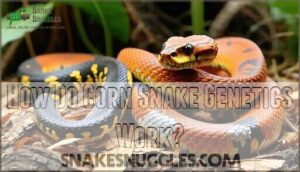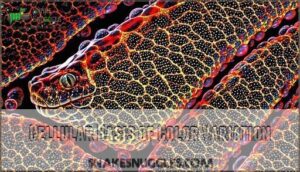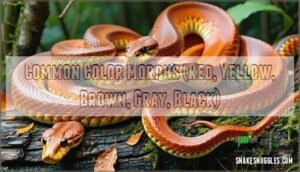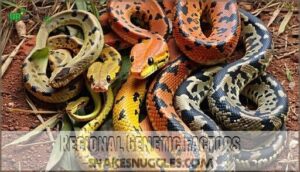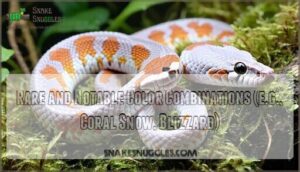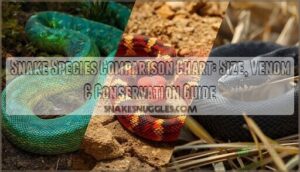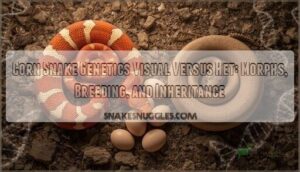This site is supported by our readers. We may earn a commission, at no cost to you, if you purchase through links.
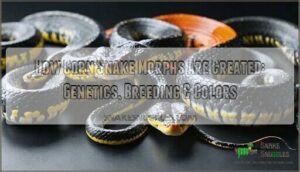
Understanding how corn snake morphs are created reveals a fascinating intersection of Mendelian genetics, patient breeding programs spanning multiple generations, and the careful documentation of inheritance patterns. The process combines scientific precision with creative vision, as breeders stack mutations, predict offspring outcomes using Punnett squares, and occasionally stumble upon entirely new color combinations that reshape what’s possible in captive corn snake genetics.
Table Of Contents
Key Takeaways
- Corn snake morphs are created through selective breeding that manipulates dominant and recessive genes across multiple generations, with breeders using Punnett squares to predict offspring outcomes and stacking mutations to produce hundreds of distinct color and pattern combinations.
- Each morph results from specific genetic mutations affecting chromatophores (pigment cells), where changes to melanin and other compounds create everything from vibrant reds to stark whites, with some rare morphs like Coral Snow combining three recessive genes.
- Breeding new morphs requires three to five generations spanning five to eight years, with complex multi-trait combinations demanding patient documentation of inheritance patterns and strategic pairing decisions to achieve stable, reproducible results.
- Morph pricing reflects genetic complexity and breeding difficulty, ranging from $40 for common single-trait variants to over $1,000 for rare multi-gene combinations, with breeder reputation adding 25–40% premiums and certain morphs requiring specialized care considerations like elevated humidity or light sensitivity.
What Are Corn Snake Morphs?
A corn snake morph is simply a variant that looks different from the wild-type snake you’d find in nature. These variations come from careful breeding that highlights specific colors, patterns, or both.
So what actually sets morphs apart from the snakes you’d encounter in the wild?
Definition and Importance of Morphs
When you hear "corn snake morph," think of it as nature’s color palette gone creative. It’s basically a genetic twist that alters the snake’s colors, patterns, or both—giving you something visually distinct from the standard wild-type look.
What makes morphs interesting? They’re living examples of genetic diversity in action. If you’re just starting out with corn snakes, morphs give you a window into how reptile genetics actually work, plus they make identifying different snakes way more straightforward.
And let’s be honest—the color variations are genuinely stunning, and the genetics behind them follow patterns you can actually predict and understand.
Why morphs are important:
- Genetic Diversity: Each morph represents a distinct genetic trait that can be studied and preserved
- Trait Significance: Different morphs help breeders predict offspring appearance through genetic inheritance
- Beginner Appeal: Snake morphs offer accessible entry points for new reptile enthusiasts
- Conservation Impact: Understanding wild-type genetics aids healthy captive breeding programs
- Market Value: Rare corn snake morphs drive breeding innovation and community engagement
Wild-Type Vs. Designer Morphs
When you look at wild-type corn snakes compared to designer morphs, you’re seeing the difference between nature’s original blueprint and decades of careful genetic selection. Wildtype corn snakes display earthy reds, browns, and yellows found in their natural habitats, while designer snakes showcase striking color variations bred through controlled genetic inheritance.
The explosion in morph breeding has sparked real debates about genetic diversity and wild population health.
Though it’s worth noting that responsible breeders take these concerns seriously and maintain rigorous health standards even as new color possibilities keep emerging.
Overview of Pattern and Color Variations
Your corn snake’s appearance isn’t just about being red or brown—it’s the result of two separate genetic systems working together to produce pattern and color combinations that number in the hundreds.
Pattern types like motley, stripe, and blotched work independently from color variations, allowing breeders to combine traits into designer morphs.
Snake color genetics determine pigment expression, while pattern morphs control marking arrangement, creating everything from simple single-trait corn snake morphs to complex multi-gene combinations that showcase future trends in color inheritance.
How Do Corn Snake Genetics Work?
Corn snake genetics might sound intimidating, but it’s actually pretty straightforward once you know the basics. It all comes down to understanding how traits move from one generation to the next—specifically, how genes dictate the patterns and colors you see on these snakes.
Here are the core concepts that’ll help you understand how these beautiful morphs come to life.
Dominant and Recessive Genes
Every trait you see in a corn snake—from its crimson saddles to its ghostly gray scales—comes down to a genetic instruction carried in one of two forms: dominant or recessive.
Dominant genes express visual traits even when paired with a recessive counterpart, creating heterozygous traits that show genetic dominance. Recessive traits only appear when both genes match.
You can predict gene expression using Punnett squares, making reptile genetics a fascinating puzzle of genetic inheritance.
Genetic Inheritance Patterns
Because corn snakes follow predictable Mendelian ratios, you can forecast offspring outcomes with precision. Crossing two heterozygous parents yields roughly 3:1 ratios for single recessive traits—say, 76% normal to 24% albino. Dihybrid crosses produce the classic 9:3:3:1 distribution, blending pattern and color. Corn snakes are often used to illustrate dihybrid crosses in biology classes.
Allele frequency, genetic linkage, and mutation rates all influence which genetic traits appear. Chromatophore factors determine visible color, while reptile genetics reveals how dominant genes and recessive traits interact across generations.
Single-Trait Vs. Multi-Trait Morphs
When a morph shows only one genetic change—like amelanism stripping away black pigment—you’re looking at a single-trait morph. Single-trait morphs show straightforward genetic inheritance with predictable dominant genes or recessive traits, making morph identification easier.
Stack multiple mutations together and you access the vibrant complexity of multi-trait combinations. Multi-trait combinations involve trait interaction across several genetic traits, boosting visual impact but increasing breeding complexity and affecting genetic stability as you manage multiple polygenic traits simultaneously.
Predicting Offspring Appearance
If you’ve mapped out which genes each parent carries, calculating the likelihood of specific colors and patterns in their babies becomes surprisingly mathematical. Punnett squares let you predict offspring colors by charting gene interactions between dominant and recessive genes. Here’s how breeding outcomes take shape:
- Single-gene crosses reveal straightforward visual traits
- Dihybrid crosses expose mutation impact across two genetic traits
- Multi-gene scenarios demand complex calculations for accurate genetic inheritance predictions
What Genetic Mutations Create Color Morphs?
Color morphs aren’t just about pretty patterns—they’re the result of specific genetic mutations that change how pigment cells work at the cellular level. These mutations affect different color pigments, creating everything from fiery reds to sleek blacks.
These genetic shifts are what create the stunning variety of corn snake colors you see today.
Cellular Basis of Color Variation
Color in corn snakes isn’t just skin deep—it starts at the cellular level, where specialized pigment cells called chromatophores determine whether your snake will glow red, fade to white, or display something in between.
These pigment cells contain melanin and other compounds that absorb or reflect light differently. Genetic expression controls which cellular processes activate, directly influencing skin coloration.
When mutations alter this genetic control of animal coloration, you get the stunning diversity of morphs available today.
Common Color Morphs (Red, Yellow, Brown, Gray, Black)
From fiery reds to sleek blacks, the spectrum of corn snake colors reads like a painter’s palette—and each hue tells a genetic story. Red and orange morphs like Blood Red and Crimson showcase vibrant coloration through melanin shifts.
Yellow hues and brown variations, including Caramel and Honey, display warm, earthy tones.
Gray shades and black morphs—Anerythristic and Charcoal—demonstrate refined beauty.
These color combinations create over 800 distinct corn snake morphs.
Regional Genetic Factors
Geography plays a surprisingly powerful role in shaping corn snake genetics, with wild populations developing distinct color traits based on where they evolved. Local adaptation drives these locality differences—isolated populations in Florida’s pine forests develop different pigmentation than those in Oklahoma’s prairies.
Environmental influence and limited gene flow between regions create unique genetic variation in wild-caught specimens. You’ll notice wildtype corn snakes from different areas display distinctive patterns, reflecting the evolution of skin patterns shaped by their specific habitats over thousands of generations.
Rare and Notable Color Combinations (e.g., Coral Snow, Blizzard)
When breeders push genetic complexity beyond standard combinations, remarkable corn snake morphs emerge. Coral Snow combines three recessive genes—Amelanistic, Anerythristic, and Hypomelanistic A—creating vibrant pink, orange, and white tones with impressive visual consistency into adulthood. Blizzard morphs, pairing Amelanistic and Charcoal genes, produce stark white or pale gray snakes lacking both red and yellow pigments.
These rare color combinations constitute less than 2% of captive markets, with morph rarity driving market prices above $200. Bloodline validation through tracked genetics ensures genetic purity in sought-after lines like JMG Snow Corns. A common Carolina corn snake will usually cost between $30 and $50.
How Are New Corn Snake Morphs Bred?
Creating new corn snake morphs isn’t just luck—it’s strategic breeding that pairs specific genetics to create fresh combinations. You’ll need to understand how traits combine, select the right parent snakes, and often wait through multiple generations to achieve your vision.
Here’s how breeders actually pull off these stunning new combinations.
Selective Breeding Techniques
When you want to create a specific corn snake morph, you’re basically playing matchmaker with genetics, pairing snakes that carry the exact traits you’re trying to express in their babies.
Successful breeding programs rely on line breeding to strengthen desired characteristics, while careful trait fixation ensures mutations stay stable across generations.
You’ll use mutation stacking to combine multiple traits, though you need to watch for genetic bottlenecks that can weaken your stock.
These reptile breeding techniques require patience, detailed record-keeping, and strategic pairing decisions that span multiple generations.
Combining Patterns and Colors
Once you’ve got your genetic foundation locked in through selective breeding, the real artistry begins—layering pattern mutations on top of color mutations to craft combinations that didn’t exist in nature.
You’ll pair pattern interactions like motley with color intensifiers such as hypo to heighten visual harmony.
These breeding goals focus on balancing color variations with genetic complexity, ensuring your color combinations showcase morph aesthetics while highlighting how genetic mutations transform standard color patterns into stunning designer snakes.
Creating and Naming New Morphs
After perfecting your designer combo, you’ll need to establish whether it’s genuinely novel and decide what to call it—because the reptile community won’t recognize your creation until it has a name that sticks.
You’ll document trait combinations thoroughly, ensuring your genetic innovation doesn’t duplicate existing designer snake morphs. Morph naming follows breeding ethics—you can’t claim novelty without proving genetic uniqueness through selective breeding records.
Your breeding programs must demonstrate consistent inheritance before market impact kicks in, as corn snake morphs gain credibility only when genetic mutations reliably reproduce across generations.
Challenges in Breeding Rare Morphs
Pursuing rare morphs brings serious hurdles despite their rarity and complexity. Genetic bottlenecks from intensive line-breeding drive up congenital defects—some projects report 13% embryonic malformations. Female health suffers dramatically, with mortality rates 2.5 times higher due to egg binding and reproductive complications. Market volatility means your $3,200 investment can lose 50% of its value within two breeding seasons.
Consider these breeding technique obstacles:
- Reproductive output drops to 40–60% compared to 80–90% for common morphs
- Genetic viability concerns emerge—certain pairings yield 20–30% nonviable hatchlings
- Recessive genes require multiple generations to isolate, testing breeder reputation and patience
- Genetic complexity increases, with rare alleles carrying up to 1.26 cosegregating variants per kilobase
What Factors Affect Corn Snake Morph Pricing?
Shopping for a corn snake morph? Prices are all over the map.
Knowing what affects the cost means you won’t get ripped off and can find the right snake for your budget.
Here’s what really goes into the price you’ll pay for a corn snake morph.
Rarity and Genetic Complexity
The price tag on a corn snake morph tells a genetic story—one written in chromosomes, breeding difficulty, and pure scarcity. Morphs involving recessive genes or dihybrid crosses demand years of selective breeding to produce, creating genetic bottlenecks that limit supply.
This rarity and complexity directly impacts pricing—simple morphs start around $40, while multi-trait combinations with stacked genetic mutations can exceed $1,000, reflecting both breeding challenges and morph demand.
Breeder Reputation and Market Trends
You’ll notice breeder reputation acts like a multiplier in the corn snake market—trusted sellers command 25–40% price premiums for identical morphs compared to unknown sources. Over 85% of buyers check reviews before purchasing, and breeders with strong feedback see 60% more page views and sell through inventory in just 10 days versus 45 for others.
This breeder transparency drives pricing dynamics and morph popularity, especially in online sales where top vendors control nearly 38% of the $12 million U.S. market. Industry growth favors established names with price stability and investment potential rooted in documented lineage.
Care Considerations for Unique Morphs
While most corn snake morphs don’t require radically different care, some genetic traits can make them more sensitive to their surroundings than their wild-type relatives. It’s a good idea to keep an eye on a few key areas:
- Humidity: Leucistic and albino morphs often do better with slightly higher humidity, especially to avoid shedding problems.
- Light: Amelanistic snakes can be more sensitive to bright light, so make sure their enclosure includes plenty of shaded spots.
- Temperament: Some captive-bred lines are noticeably more relaxed, while others might still show defensive behaviors.
- Feeding: Certain morphs may be a bit less eager to eat, so you’ll need some extra patience at mealtime.
- Veterinary care: Snakes with scale mutations sometimes benefit from specialized husbandry and extra attention.
By understanding these care details, you’ll help your corn snake morph thrive and stay healthy.
Price Ranges for Common and Rare Morphs
If you’re shopping for your first corn snake morph, expect to pay anywhere from $40 for a standard variant to well over $1,000 for a state-of-the-art genetic masterpiece. Morph Market Value depends heavily on rarity price impact, with breeding cost analysis revealing why some morphs command premium prices while others remain budget-friendly.
Snake morphs with complex genetics fetch higher prices initially, though corn snake pricing often stabilizes as availability increases.
| Morph Category | Price Range | Investment Potential |
|---|---|---|
| Common morphs (Amelanistic, Anerythristic) | $40–$120 | Low; excellent for beginners |
| Intermediate combinations | $150–$400 | Moderate; growing morph popularity |
| Rare multi-trait morphs (Coral Snow, Blizzard) | $500–$6,000+ | High; ethical pricing considerations |
Frequently Asked Questions (FAQs)
How long does breeding a new morph take?
Creating a stable, new morph through selective breeding generally takes three to five generations, spanning roughly five to eight years. Each generation length depends on reaching sexual maturity, successful mating, and achieving genetic stability.
Multi-trait morphs with increased complexity require longer timelines before you’ll see consistent, marketable results.
Can morphs breed with wild-type corn snakes?
Yes, morphs can breed with wild-type corn snakes. Breeding them produces offspring that blend traits, creating genetic diversity and hybrid vigor.
Offspring viability remains strong, though trait dilution may reduce the visual impact of rare morphs in successive generations.
What permits are needed for breeding corn snakes?
Let me search for more specific information about corn snake breeding permits and regulations.
How do environmental conditions influence morph development?
Environmental conditions don’t actually change your corn snake’s genetic morph or pigmentation.
Temperature, humidity, and lighting influence skin coloration temporarily through chromatophores, but diet variations and habitat complexity won’t alter the cellular mechanisms determining inherited color patterns.
Conclusion
Like alchemists transmuting base metals into gold, modern breeders transform genetic code into living art through strategic pairings and patient observation. Each carefully documented breeding reveals how corn snake morphs are created—not through chance, but through mastering inheritance patterns that Mendel himself would recognize.
Modern breeders turn genetic code into living art, mastering inheritance to create corn snake morphs that nature never imagined
Your phantom whites and midnight blacks exist because someone understood that recessive genes, when properly combined across generations, release colors nature never showcased in the wild. The next significant morph might emerge from your own breeding room, waiting in genetic silence until the right pairing brings it into existence.
- https://a-z-animals.com/blog/corn-snake-morphs-the-complete-list/
- https://scitechdaily.com/the-hidden-code-that-turns-corn-snakes-into-living-works-of-art/
- https://www.nature.com/articles/s41467-024-51927-0
- https://pmc.ncbi.nlm.nih.gov/articles/PMC7584913/
- https://cornsnake.net/blogs/stories/the-story-of-the-palmetto-corn-snake

